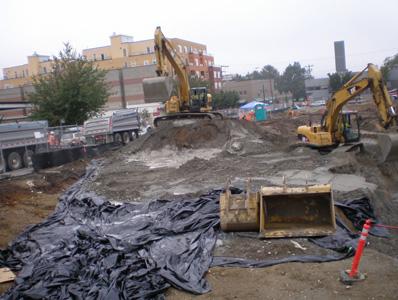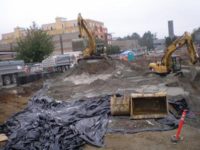The cleanup action involved:
- Decommissioning of monitoring wells;
- Permanent decommissioning by removal of six USTs;
- Performance of a pre-excavation soil profile investigation;
- Excavation and removal of soil with concentrations of petroleum hydrocarbons, BTEX, and/or PCE;
- Sampling of water generated from dewatering during construction; and
- Evaluation of groundwater conditions following excavation activities.
Excavation of the property generally resulted in an 18- to 20-foot lowering of the pre-excavation surface grade. A few site areas were excavated as much as 24 feet below the pre-excavation surface grade to allow access to and removal of soil with one or more contaminants exceeding cleanup levels, and to facilitate redevelopment.
Nearly 18,000 tons of petroleum hydrocarbon-contaminated soil and over 5,000 tons of PCE-contaminated soil was profiled and managed for off-site disposal during the cleanup action. Confirmation soil sample analytical results indicated that the potential risks to human health and the environment from exposure to contaminated soil were mitigated by the cleanup action. Because redevelopment activities resulted in removal of the upper portion of the water-bearing zone at the site, Farallon proposed to Ecology that confirmation groundwater monitoring was no longer applicable to meet State regulatory closure requirements. Ecology concurred with Farallon's conclusions, and issued a No Further Action determination for the site.

